Ever wondered what the hell is the difference between live resin and live rosin—and why it matters for your high? In this special 7/10 edition of The High Guide, April Pride sits down with Elise McRoberts, Chief Marketing Officer of Doc Greens, to decode the textures, terms, and techniques behind today’s cannabis concentrates. Whether you're dabbing for the first time or refining your palette as a self-proclaimed solventless snob, this episode unpacks the science and the slang so you can walk into a dispensary (or dab party) with confidence. From hash history to modern rosin rituals, Elise and April offer a cultural, technical, and experiential guide to navigating the ever-expanding concentrate landscape.
🔵 Key Takeaways
Solventless cannabis concentrates like live rosin are made without chemicals—just ice, water, and pressure.
Both live resin and live rosin begin with "fresh frozen" flower, but live resin uses solvents like butane (BHO), while rosin does not.
The texture of concentrates (badder, budder, diamonds) doesn't determine quality—it’s about starting material and method.
Fresh frozen flower retains more terpenes, delivering more authentic plant medicine.
Some strains don’t “wash well” into hash, so BHO can still serve high-quality purposes.
🔵 Timestamps
[00:09] Elise asks the budtenders: who actually knows the difference between live rosin and resin?
[00:25] April confesses her confusion—and outlines what this episode will unpack
[01:19] What's the deal with texture terms like badder, budder, and diamonds?
[02:01] Why hash is the original concentrate—and what makes it so sacred
[02:47] “Modern hash” as the evolution of ancient practice
[03:08] Rosin revolution: why we’re in a solventless renaissance
[04:23] Live resin vs. live rosin explained—finally
[04:46] What “fresh frozen” really means and why terpene retention matters
[06:12] Solvent-based methods decoded: butane, hydrocarbons, and BHO
[07:09] How to decode store shelf products: it’s all about input and process
[07:38] Why Elise sticks to solventless—and when BHO still makes sense
[08:54] Recap: solvents, textures, terpene talk, and trust in your budtender
[09:49] How to stay connected: Clubhouse Fridays, Instagram, and The High Guide newsletter
🔵 Featured Guest
Elise McRoberts | @elisemcroberts
🔵 Additional Resources
SetSet Blog: “Cannabis Concentrates: How to Smoke Wax”
SetSet Blog: “Cannabis Dab Rigs, Quartz Bangers, and More”
SetSet Blog: “The Ultimate Guide to the Best Cannabis Terpenes”
🎙️ SetSet Podcast: Ep. 10 “Cannabis Concentrates and Dabbing Explained”
🎙️ SetSet Podcast: Ep. 12 “Electric Dab Rig: Why It’s Worth the Investment”
How do you choose your concentrates—texture, terpenes, or technique? What do you love (or not love) about live rosin? 👇 Let’s talk about it in the comments after the transcript below.
🔵 Transcript
[00:00] April Pride:
This podcast discusses cannabis and is intended for audiences 21 and over.
[00:09] Elise McRoberts:
I think we still have a long way to go because I actually go into all of our retail partners, and I always ask in the training, who knows the difference between [live rosin] and [live resin], and more times than not, the majority of the people working don't know.
[00:25] April Pride:
Welcome to The High Guide. I'm your host, April Pride. The first time I saw the word rosin, I assumed it was a misspelling of resin, and when I started seeing [live rosin] and [live resin] on menus at cannabis shops, I only got more confused. Nowadays, it seems as though there's a new type and texture of [cannabis concentrates] appearing on the regular. With the 7/10 or July 10th or the 420 of oil-based extract celebration happening tomorrow, this episode of The High Guide gathers up the latest and greatest in [dabbing] and sorts it out, so you can approach concentrates and tomorrow's high holiday with a little more confidence thanks to today's High Guide, Elise McRoberts, CMO of Doc Greens, a Bay Area cannabis company dedicated to 21st-century [hash]. Are you intrigued? Here's more of what Elise will share with us on today's 7/10 dedicated show.
[01:19] April Pride:
What does [hash] have to do with oil and a vape pen, what's the difference between [live resin] and [live rosin], and why does it matter? The difference between badder, budder, and diamonds, and what qualifies someone as a solventless snob. [Cannabis concentrates] are confusing, right? There are lots of different types, they all are similar in color, some are more yellow, some are more brown, some are crumbly, viscosity is different. Can you just tell us what's up with all of the concentrates, why you would choose one over another?
[02:01] Elise McRoberts:
So I love to start with [hash], the original concentrate. [Hash] has been around obviously as long as the cannabis plant, and I believe humans have been consuming [hash] since biblical times. And [hash] is a concentrate that has been consumed around the world, and what [hash] is, is essentially it's just the separated resin from the cannabis plant matter. What those trichomes hold are the cannabinoids, the terpenes, the flavonoids. And then so you're getting all of that in a concentrated form, but essentially [hash] is the original concentrate.
[02:37] April Pride:
Okay, so [hash] is the OG of the concentrate world, but how does the age-old extract influence the new age of products appearing?
[02:47] Elise McRoberts:
Everything today, which even a lot of people just call [live rosin] or [live resin] hash for slang. We call it modern hash because we're doing the same thing: collecting the resin or cannabis trichomes and separating them from the plant matter—the things you don't want like fats, waxes, lipids that you do get when you combust flower.
[03:08] April Pride:
I do want to ask you a question, Elise, because [live rosin], [fresh frozen]—these are terms that like nobody was using six months ago, and now it's everywhere.
[03:25] Elise McRoberts:
I think we're just in the midst of the rosin revolution or solventless renaissance, meaning that, like you said, these terms and products are getting somewhat into the mainstream. [Live rosin], or what people refer to as solventless extracts, don't use any chemical or hydrocarbon solvents to separate the resin from the plant. We just take the [fresh frozen] flower, make ice water hash the traditional way—putting the flower into bath devices and mesh bags—collecting the [hash] through the bags, freeze-drying it, and then pressing it into [live rosin] with just minimal heat and pressure. So nothing is touching the flower aside from ice and water before it becomes rosin. Both [live rosin] and [live resin] start from [fresh frozen] flower, and then the difference is, [live resin] uses a [hydrocarbon extraction] method to separate the resin from the plant material.
[04:23] April Pride:
Okay. Wow, I just had a lightbulb moment. Eureka. I've been shaky on my understanding of [live rosin] and [live resin] until now. So both start with [fresh frozen] cannabis, which is why it’s called “live,” but rosin means [solventless extraction] and resin indicates solvent-based. But what's the difference between starting with live or [fresh frozen] plant matter and traditionally cured cannabis?
[04:46] Elise McRoberts:
[Fresh frozen] means as soon as the flower is harvested—ideally at its peak—it must be frozen within an hour to be considered [fresh frozen]. What that freezing does is basically stop time for that cannabis plant. As it hangs to cure or is left out, all those terpenes are so volatile, they're coming off every moment. So freezing locks in those terpenes, preserving the plant’s full profile. When you later make hash and press it into [live rosin], you're essentially getting true plant medicine, preserved as close to nature's intention as possible.
[05:49] April Pride:
Okay, so my understanding of starting material and [solventless extraction] has just leveled up tremendously, which takes us to the next topic: solvent-based extraction, more commonly known as [hydrocarbon extraction]. These are concentrates that utilize solvents to separate the trichomes and come in all kinds of textures.
[06:12] Elise McRoberts:
[Hydrocarbon extraction] methods use [butane], pentane, hexane—that’s the solvent used to extract the resin. And then also in the hydrocarbon category would be [live resin], which [BHO] stands for butane hash oil. So [butane] is primarily the most popular when it comes to [hydrocarbon extraction]. Sugar, diamonds and sauce, all these budders and badders really just refer to the texture of the end product. Most of those are [BHO] or other [hydrocarbon extraction] types. Some people use ethanol and CO2.
[07:09] April Pride:
So this concentrate conversation is getting less confusing by the second, right? We see a wide variety of [hydrocarbon extraction] concentrates on store shelves these days, but it's really just a matter of the starting material—cured or [fresh frozen], the chosen solvent—[BHO], PHO, CO2—and the resulting texture—budder, badder, shatter, or diamonds—that determines what the product is called. But once you head back into the world of [solventless cannabis concentrates], how does one choose which to consume?
[07:38] Elise McRoberts:
Why should high-quality products be a luxury? I pretty much, I guess I'm a solventless snob, and I pretty much stick to [live rosin] products that were made without solvents. However, I have had some good [BHO], or [live resin]. And I’m not knocking that—I just don’t consume it as much. Not all cultivars will work for [hash]. Some don’t “wash well” or yield well, and so you won’t get that great terpene expression in the [hash]. But you can still get good results with [BHO].
[08:54] April Pride:
Well, there you have it. While there's no shortage of options for concentrate consumption, we hope you feel more informed on which one suits your style. A quick review. What's the difference between [live resin] and [live rosin]? While both start with [fresh frozen] flower, [live resin] uses a solvent for extraction and [live rosin] is [solventless]. One great reason to choose [fresh frozen] product? [Terpene retention]. What's the most common solvent used in extraction today? [Butane], which makes [BHO]. Should you find yourself confused between budder, badder, and diamonds, just think texture. Feel free to ask your budtender for clarification on the extraction method and starting material. If they don't know, they can find out. And remember, people consider themselves solventless snobs for good reason, but that doesn't mean that [hydrocarbon extraction] concentrates are inherently dangerous. It's a matter of plants, purity, and ultimately preference.
[09:49] April Pride:
Thanks for listening to this episode and join me, April Pride, every Friday at 1:00 PM Pacific in Clubhouse, where we cover all things A to Z plant-based pleasures. Of course, you can find a new episode of The High Guide every Friday. Subscribe and follow wherever you listen to podcasts. And if you're looking to stay in closer contact, give us a follow on Instagram @thehighguide and subscribe to our newsletter at www.thehighguide.


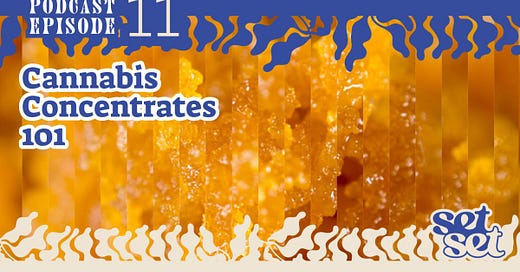
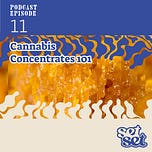





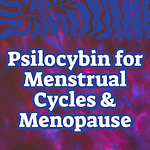

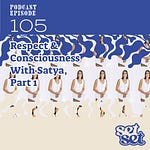
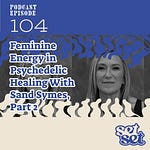

Share this post